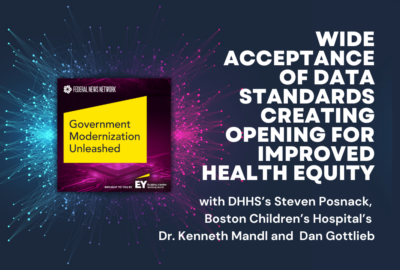Sponsored by Noblis
Molecular surveillance advances with IT, skills investments
Technology for detecting and identifying molecular health hazards grows less expensive and more portable. The large data sets it generates requires investment in...
In the ever-evolving work of protecting public health, the nation has benefited from regular advancements in technologies for detecting and identifying pathogens. In fact, the Centers for Disease Control and Prevention has a special unit called the Office of Advanced Molecular Detection (OAMD.) It’s dedicated to advancing such technologies.
“The primary job of the OAMD is to help guide that innovation towards public health applications,” said Director Duncan MacCannell. “And to help figure out how to use these technologies to keep the public safe.”
The OAMD, which recently celebrated 10 years in business, focuses on pathogen genomics — the genetic makeup of germs — and on bioinformatics and epidemiology. MacCannell said building capability in these three areas requires investment not just in laboratories and server rooms.
“It also means investing in people and ensuring that we have a strong, capable technical workforce that is able to actually use these technologies,” he said.
Applications of genomics, informatics and epidemiology span a wide range of domains affected by pathogens, MacCannell said, including foodborne disease, antimicrobial or antibiotic resistance, virus outbreaks, “and including the massive scaling up of variance surveillance for the COVID-19 response.”
The challenge ahead for molecular detection in particular and biohazard surveillance in general, MacCannell said, is how to build more agility and versatility into federal, state and local capabilities. When COVID-19 became the national priority, CDC found that “even though virtually all state and local public health departments had sequencing capability in-house, a lot of it was built around existing programs of foodborne surveillance or flu surveillance.”
Not all of these entities possessed the skills to “pivot their resources and make sure that we could actually use them for a new and emerging threat,” MacCannell said. He said the next challenge lies in “ensuring that we have the kind of flexibility across the public health system to respond to not only the threats we know, but also the threats we can anticipate and some that we might not.”
Improving informatics
Ideally, public health researchers and practitioners would have available digital libraries of information about viruses and bacteria — what MacCannell called “good reference databases that we can compare against.” For instance, if surveillance turns up something new in the wild, a strong database of pathogens and so-called commensal organisms, those that live on or around humans and animals, would be instrumental in understanding what’s going on and speeding response.
Genetically mapping organisms generates massive amount of data, MacCannell said, requiring serious information technology and skills investments. The human capital need forms another instance of government competing with industry and academia for people.
A decade ago, the state of the art for foodborne disease surveillance was a technique called pulse field gel electrophoresis to create a sort of fingerprint of the bacteria. Nowadays, MacCannell said, analysts use genomic sequencing. The newer methodology dramatically improved the accuracy and speed of tying disease outbreaks to specific food sources, but at the cost of new skills requirements, and of much larger data.
Moreover, the distributed nature of public health surveillance, discovery and response make for difficult resource questions, MacCannell said. Central hub-like labs, such as exist throughout CDC, use the agency’s high performance computing resources (although these lag behind those of other federal entities, he said).
But numerous state and local agencies’ labs all needing to run similar molecular assays strains both human and computing resources, MacCannell said.
One solution: Moving to commercial cloud computing. MacCannell outlined an initiative called Advanced Molecular Detection Platform “that will hopefully, in the very near future, make a lot of these resources more available to U.S. public health laboratories.” He said the cloud will “extend work that we’ve done that’s been mostly focused on CDC’s IT environment.”
Better detection
In terms of effective response, detection is as much about identification of a molecular hazard as knowing something is out there.
“There has been just an incredible amount of advancement in these technologies themselves,” MacCannell said of detection systems, “whether that is in genomic sequencing approaches, the systems that have been developed [and] the portability of these systems.”
Some sequencing apparatus now fits on a lab bench and “we’ve got others about the size of a paperback book that can be put into Pelican cases and transported anywhere.” For instance, CDC has sent portable systems to state fairs to detect, identify and mitigate flu viruses that jump from the animals to the visitors, MacCannell said.
He noted that sequencing technology is not only shrinking, it’s also becoming less expensive. And “much easier for people to implement. We’re now seeing high school classes that are using sequencing. It’s increasingly getting much more ubiquitous,” MacCannell said.
At the federal level alone, advanced molecular detection for public health requires massive interagency cooperation, especially within the far-flung Health and Human Services Department. MacCannell named the Advanced Research Projects Agency for Health, known as ARPA-H, as a close collaborator, partly to share knowledge and partly to avoid duplication. OAMD also works with parts of the National Institutes of Health, in particular the National Institute of Allergy and Infectious Diseases and the National Center for Biotechnology Information (NCBI).
The NCBI, MacCannell said, “has become an absolutely critical resource to manage, present and share a lot of these data that are being generated.”
Listen to the full show:
Copyright © 2025 Federal News Network. All rights reserved. This website is not intended for users located within the European Economic Area.
Tom Temin is host of the Federal Drive and has been providing insight on federal technology and management issues for more than 30 years.
Follow @tteminWFED





